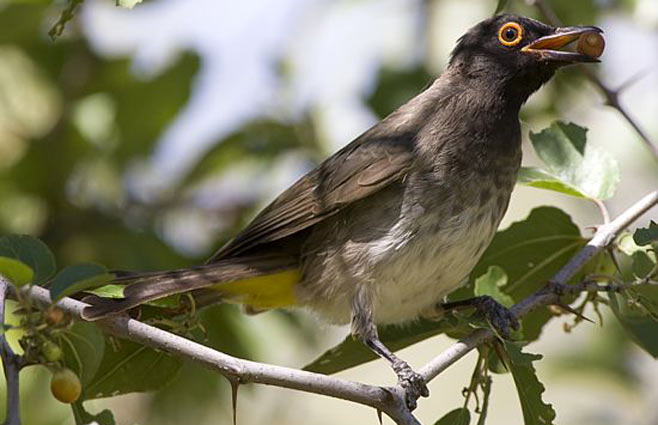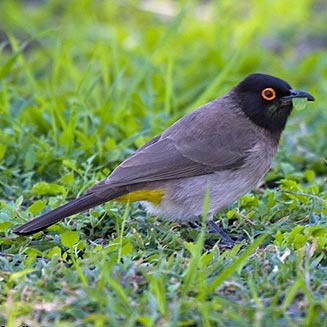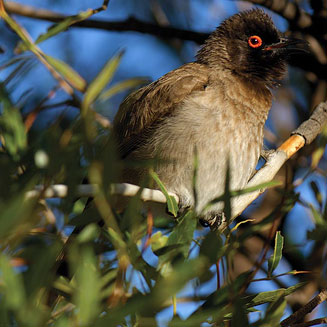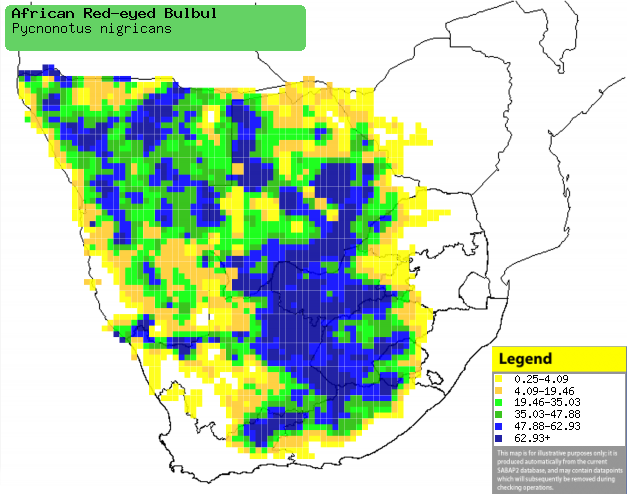|
Pycnonotus nigricans (African
red-eyed bulbul, Red-eyed bulbul)
Rooioogtiptol [Afrikaans]; Mburukutji (generic term for
bulbul) [Kwangali]; Hlakahlothoana (also applied to Dark-capped bulbul),
Kaka-hlotoana [South Sotho]; Rramorutiakolê [Tswana]; Maskerbuulbuul
[Dutch]; Bulbul brunoir [French]; Maskenbülbül [German];
Tuta-de-olhos-vermelhos [Portuguese]
Life
> Eukaryotes >
Opisthokonta
> Metazoa (animals) >
Bilateria >
Deuterostomia > Chordata >
Craniata > Vertebrata (vertebrates) > Gnathostomata (jawed
vertebrates) > Teleostomi (teleost fish) > Osteichthyes (bony fish) > Class:
Sarcopterygii (lobe-finned
fish) > Stegocephalia (terrestrial
vertebrates) > Tetrapoda
(four-legged vertebrates) > Reptiliomorpha > Amniota >
Reptilia (reptiles) >
Romeriida > Diapsida > Archosauromorpha > Archosauria >
Dinosauria
(dinosaurs) > Saurischia > Theropoda (bipedal predatory dinosaurs) >
Coelurosauria > Maniraptora > Aves
(birds) > Order: Passeriformes
> Family: Pycnonotidae
 |
|
African red-eyed bulbul, Rooipoort Nature Reserve,
South Africa. [photo Trevor Hardaker ©] |
 |
 |
|
African red-eyed bulbul. [photo
Neil Gray
©] |
African red-eyed bulbul. [photo Sion Stanton ©] |
Distribution and habitat
Near endemic to southern Africa, marginally extending into
southern Angola and Zambia. In southern Africa it is common across Namibia,
Botswana, and central South Africa, centered around the Free State, North-West
Province and inland Eastern Cape, also extending in to other provinces. Occurs
in a wide variety of arid and semi-arid habitats, such Acacia savanna,
semi-arid shrublands, riverine bush and gardens in arid areas.
|
 |
|
Distribution of African red-eyed bulbul in southern Africa,
based on statistical smoothing of the records from first SA Bird Atlas
Project (©
Animal Demography unit, University of
Cape Town; smoothing by Birgit Erni and Francesca Little). Colours range
from dark blue (most common) through to yellow (least common).
See here for the latest distribution
from the SABAP2. |
Brood parasites
It has been recorded as host of the
Jacobin cuckoo.
Movements and migrations
Semi-migratory in the northern areas of its
range, with large flocks arriving in the Okavango Delta and Zimbabwe
during the during the dry season.
Food
It mainly eats fruit, supplemented with nectar, flowers and
arthropods. It typically forages in pairs or large groups, who eat fruit and
hawk insects. The following food items have been recorded
in its diet:
- Fruit (such as Pheonx reclinata (Wild Date Palm)
- Flower petals (such as Homeria pallida (Transvaal Yellow Tulp)
- Nectar of Aloe
- Arthropods
Breeding
- Monogamous and highly territorial, with males aggressively defending their
territory against other males. If threatened it lowers its head and crest,
while slightly raising its wings. If the standoff escalates it will attack
the other male, viciously pecking, beating and scratching, occasionally
interlocking feet and falling to the ground.
- The nest is typically built by the female, and is a untidy cup of fine
twigs, dry grass and other small plant fibres, reinforced with spider web.
It is usually concealed in the fork of a bush or tree branch, occasionally
on a grape vine support frame.
- Egg-laying season is from September-April, peaking around
October-December.
- It lays 2-3 eggs which are incubated solely by the female for about
11-13 days.
- The chicks are fed by both parents, leaving the nest after about 12 days
(recorded in captivity), and can fly competently roughly a week later.
Threats
Not threatened.
References
-
Hockey PAR, Dean WRJ and Ryan PG 2005. Roberts
- Birds of southern Africa, VIIth ed. The Trustees of the John Voelcker
Bird Book Fund, Cape Town.
-
Harrison, J.A., Allan, D.G., Underhill, L.G., Herremans, M.,
Tree. A.J., Parker, V. & Brown, C.J. (eds). 1997. The atlas of southern
African birds. Vol. 2: Passerines. BirdLife South Africa, Johannesburg.
|
